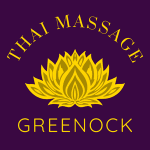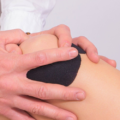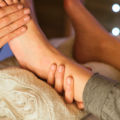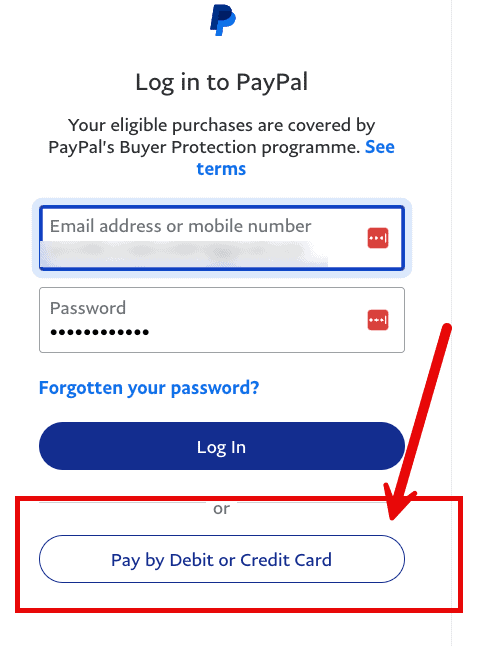Thai Massage tutorials and tips.
This article was provided by Massaqge Therapy.
Anyone who’s ever had shoulder or neck pain is familiar with those knobby lumps you might feel when you rub a sore area, known as “muscle knots.” But what exactly are they? Are they actually enlarged balls of tissue in the muscle? And while it certainly feels good (in a kind of painful but also amazing way) to apply pressure to them with deep tissue massage, do they ever really get smaller or go away? And how do you know if they’re really the source of your pain to begin with?
To get a better understanding, we talked to Dr. Clifford Stark, DO, FAOSM, the Director of Sports Medicine and Orthopedics at Sports Medicine Chelsea, and a member of the teaching faculty at NYU Langone Medical Center:
THE WHAT
The short answer is that biologists aren’t entirely sure. For a long time muscle knots could only be detected by feel, and even now it is difficult to confirm their existence with imaging, even when using advanced modalities such as MRI (though they can sometimes be detected using Ultrasound sans.) . For something most people experience at some point in their lifetime (and for most of their lifetime), why don’t we know more about it? “When you look under Ultrasound, you can sometimes see slight changes in the tissue in the area where the knot is,“ explains Dr. Stark. “We think that a knot is a chronic change in the tissue where there’s a decrease blood supply,” almost like a tiny patch of cramped muscle tissue. Or at least that’s the overly simplified answer.
Recent research is showing that the myofascial layer has a huge role in chronic muscle pain, including knots. The myofascial layer is the area where the muscle meets the fascia—the very thin, but very strong layer that covers the muscle and keeps it in place. There are a multitude of nerves running through these layers, and it’s the nerves that ultimately cause the pain.
Furthermore, some people use the terms “muscle knot” and “trigger points” interchangeably, but that isn’t always accurate. “Sometimes [muscle knots] cause irritation of nerves that are running right through there, and then it can become what’s called a ‘trigger point,’” Dr. Stark clarifies. “Lots of knots are trigger points, and when you touch them, they radiate out and are exquisitely tender.” But there is currently no evidence that knots themselves are sore, it could be the irritated nerves running under or through them.
THE WHY
One of the few elements that scientists can agree on is that knots are a chronic ailment, and are not caused by sudden trauma or injury to the area. Instead, the chronicity is likely a result of muscle overuse, or even poor posture. So whether you are regularly active and athletic, or spend most of your days in a desk chair, your lifestyle on a day-to-day basis is likely contributing to your muscle knots. Additionally, according to the Mayo Clinic, “People who frequently experience stress and anxiety may be more likely to develop trigger points in their muscles,” potentially because the emotional state of anxiety causes you to clench your muscles repeatedly, straining them and leaving your muscles susceptible to trigger points.
THE FIX
The most common recommendation for chronic muscle soreness is applying deep pressure to the trigger point with the hopes of releasing the contraction in the tissue and increasing blood flow to the area, either with massage, a foam roller or a lacrosse ball.
But these knots aren’t always deep. “Massaging them can help to break things up or bring some blood flow to the area, and perhaps help to get it to go away,” says Dr. Stark. “When people massage, they’re looking for the source of the pain—it could be very superficial, or it could be extremely deep. So if you dig down really, really deep, you might actually be missing it.” Which is why having a skilled manual therapist is paramount. “Getting the exact correct layer is very important,” adds Dr. Stark. Trained massage therapists who are good at myofascial release are those who “have a really, really good feel for where that myofascial layer is, and [know how to] release that.” Zeel’s National Community Director, Eva Carey, who oversees our network of massage therapists, agreed that myofascial release takes careful training. “Massage school training greatly focuses on techniques used to lengthen contracted muscles groups, creating a relaxing environment that is conducive to reducing stress and easing pain,” explains Carey.
So what does it feel like? “Myofascial release is not necessarily a nice deep tissue massage,” Dr. Stark advises. “If you want to release that area, you may end up pushing much less hard with the pressure to where it’s actually in that myofascial layer.” That’s not to say it isn’t relaxing, and the treatment is aimed at relieving your pain. “Myofascial release is a slow, gentle approach to lengthen muscles and improve circulation which leads to healing and overall well-being,” adds Carey.
Other remedies include a combination of applying heat and cold, and actually using the muscle to increase blood flow—like when an athlete has a cramp and is told to “walk it off.”
THE EXCEPTIONS
There are some muscle and tendon conditions that can actually be exacerbated by intense manipulation of the muscle. People who are hypermobile (which is a condition of particularly stretchy tendons and ligaments that allow joints to move beyond the normal range, also somewhat misleadingly known as “double jointedness”), sometimes have more sensitive nerves that can be irritated by aggressive pressure, having the opposite effect. “Even though it might feel good at first, [it’s] sort of perpetuating the pain cycle,” warns Dr. Stark. So as with all chronic ailments, be sure to consult a physician first.
The post What Exactly Is a Muscle Knot? appeared first on Pause: The Zeel Blog.
I hope that you found the above useful or interesting. You can find similar content on our blog: https://thaimassagegreenock.co.uk/blog/
Please let me have your feedback below in the comments section.
Thai Massage Newsletter
To make sure you don’t miss out on any new posts or promotions that we introduce, sign up for our newsletter.
Once a month we run a special promotion for our newsletter members, so sign up now to make sure you don’t miss out.
It’s free and full of great health and nutrition tips and advice on how we can help you achieve your health and fitness goals.
Let us know what topics we should cover in future.





